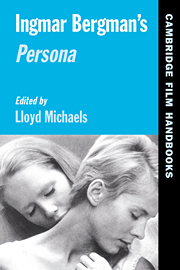Book contents
- Frontmatter
- Contents
- Acknowledgments
- List of Contributors
- Bergman and the Necessary Illusion
- 1 Bergman's Persona through a Native Mindscape
- 2 Persona and the 1960s Art Cinema
- 3 Bergman's Persona
- 4 Scenes from the Class Struggle in Sweden
- 5 Persona and the Seduction of Performance
- 6 Feminist Theory and the Performance of Lesbian Desire in Persona
- Filmography
- Reviews of Persona
- Select Bibliography
- Photographic Credits
- Index
4 - Scenes from the Class Struggle in Sweden
Persona as Brechtian Melodrama
Published online by Cambridge University Press: 29 January 2010
- Frontmatter
- Contents
- Acknowledgments
- List of Contributors
- Bergman and the Necessary Illusion
- 1 Bergman's Persona through a Native Mindscape
- 2 Persona and the 1960s Art Cinema
- 3 Bergman's Persona
- 4 Scenes from the Class Struggle in Sweden
- 5 Persona and the Seduction of Performance
- 6 Feminist Theory and the Performance of Lesbian Desire in Persona
- Filmography
- Reviews of Persona
- Select Bibliography
- Photographic Credits
- Index
Summary
To call Persona an Ingmar Bergman film seems an unproblematic statement of fact, yet this apparently innocent designation contains two crucial implications. The first is that we should see the film as an expression of Bergman's aesthetic and intellectual development. The second is that we are expected to ground our understanding in the author's intentions. Bergman, who wrote the film script while hospitalized in 1965, would later claim that making Persona saved his life or, more precisely, his life as an artist. For this reason, the dilemma of the actress Elisabet Vogler is typically seen as a projection of the director's own artistic crisis.
Much of what has been written about Persona follows this auteurist approach in which the film is regarded as a rewriting of 8½ by the Fellini of the North. The intention of this essay, however, is to examine Bergman's film through the concept of genre. Like most art films, Persona seems to defy the generic categories that comprise mainstream cinema. The art cinema, however, resembles a generic category itself by displaying certain recurrent characteristics and eliciting specific viewing practices. Two dominant traits of the art film are authorial expressivity and ambiguity. The initial responses to Persona's ambiguity reflected a 1960s film culture dominated by auteurism and new criticism and amounted to an unresolved critical debate over what the film's author was actually expressing. Meaning, we now more clearly understand, does not reside exclusively within the film text but instead involves an interaction between the film and its spectator.
- Type
- Chapter
- Information
- Ingmar Bergman's Persona , pp. 86 - 109Publisher: Cambridge University PressPrint publication year: 1999
- 1
- Cited by



